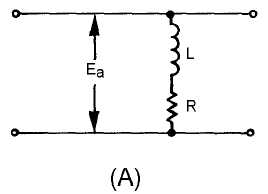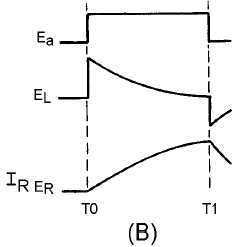3-46
Figure 3-49A.—Series LR circuit.
View (B) of figure 3-49 shows the waveforms when Ea is a square wave. Recall that the inductor
acts as an open circuit at this first instant. Current now starts to flow and develops a voltage across the
resistor. With a square wave applied, the voltage across the inductor starts to drop as soon as any voltage
appears across the resistor. This is due to the fact that the voltage across the inductor and resistor must
add up to the applied voltage.
Figure 3-49B.—Series LR circuit.
With Ea being a trapezoidal voltage, as shown in figure 3-49, view (C), the instant current flows, a
voltage appears across the resistor, and the applied voltage increases. With an increasing applied voltage,
the inductor voltage remains constant (EL) at the jump level and circuit current (I
R) rises at a linear rate
from the jump voltage point. Notice that if you add the inductor voltage (EL) and resistor voltage (ER) at
any point between times T0 and T1, the sum is the applied voltage (Ea). The key fact here is that a
trapezoidal voltage must be applied to a sweep coil to cause a linear rise of current. The linear rise of
current will cause a uniform, changing magnetic field which, in turn, will cause an electron beam to move
at a constant rate across a crt.



